(CNN) — Đa dạng. Độc đáo. Đáng nhớ.
Đó là những từ mô tả con người Việt Nam, nhưng cũng có thể dùng để nói về vô số bãi biển của đất nước này. Với hình dáng dài và hẹp, Việt Nam sở hữu 3.440 km đường bờ biển — chưa kể đến hàng trăm hòn đảo lớn nhỏ.
Từ sôi động, nổi tiếng cho đến hoang sơ, hoang dã — có một bãi biển dành cho mọi kiểu du khách. Một số người yêu nắng đổ về các điểm đến nhiệt đới nổi bật như Nha Trang, trong khi những tâm hồn phiêu lưu chọn rong ruổi bằng xe máy dọc bờ biển từ Vịnh Bắc Bộ đến Vịnh Thái Lan, tìm kiếm những bãi biển vắng bóng người.
Tuy nhiên, đi xe máy không phải là lựa chọn thực tế với phần lớn mọi người (hãy để việc đó cho dân chuyên). Dưới đây là bảy điểm đến biển hàng đầu tại Việt Nam — không cần mũ bảo hiểm hay bằng lái.
Bãi Dài, đảo Phú Quốc
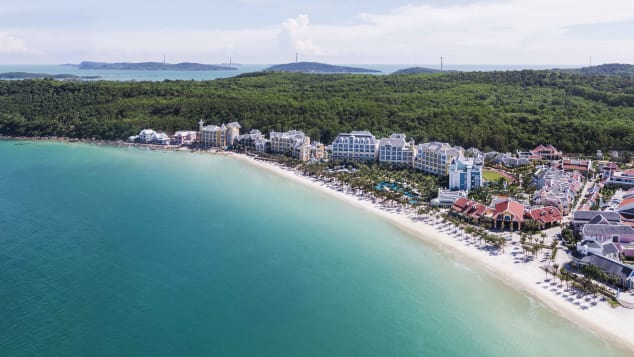
Bãi Dài trải dài hơn 19 km với làn nước trong xanh và bãi cát mịn nguyên sơ.
Với dân số 96 triệu người, Việt Nam thường nổi tiếng bởi các đô thị đông đúc và xe máy chằng chịt hơn là thiên đường nhiệt đới.
Tuy nhiên, hòn đảo lớn nhất của Việt Nam lại sở hữu cảnh quang đặc sắc khó lòng bỏ qua cùng những bãi biển không quá đông đúc. Trong đó có Bãi Dài — cái tên rất đúng với bản chất của nó.
Nằm trong Vịnh Thái Lan, Bãi Dài trải dài hơn 19 km với làn nước trong vắt, cát mịn màu be và các khu lưu trú nằm sát biển dưới tán cọ lười biếng và những dãy núi phủ rừng rậm.
Những người bán hàng đội nón lá đi quanh bãi biển, bán dứa ngọt, thanh long và dừa cho du khách tắm nắng. Phú Quốc nổi tiếng với hoàng hôn. Và vào “khung giờ vàng” này, người dân địa phương cùng du khách tụ tập tại Bãi Dài để tắm biển, uống bia lạnh, chơi đá banh hay lướt ván đến tận chân trời đang rực sáng.
Khi đêm xuống, những lò nướng bốc khói cùng hải sản tươi sống trong ngày: cá đủ loại, sò, mực. Thật quá dễ dàng để đắm chìm vào nhịp sống thư thái, thong thả nơi đây.
Đảo Côn Sơn, quần đảo Côn Đảo
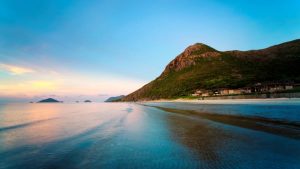
Dù chỉ là một chấm nhỏ gồm 16 hòn đảo ở cực Đông Nam Việt Nam nhưng Côn Đảo hoàn toàn xứng đáng với chuyến bay kéo dài một giờ nhờ vào những bãi biển vắng người, đường bờ biển như đang ở tận cùng thế giới. Đây cũng là nơi có nước biển màu ngọc lam và những điểm lặn đẹp nhất cả nước.
Đảo chính Côn Sơn có một số bãi biển mà ta có thể dễ dàng tiếp cận, số còn lại buộc ta phải băng qua rừng quốc gia giống như bị bỏ rơi trên đảo hoang. Six Senses Côn Đảo là khu nghỉ dưỡng năm sao duy nhất ở đây, với bãi biển riêng nằm sát chân núi đầy ấn tượng.
Người dân thân thiện, nhịp sống chậm rãi và vẻ đẹp tự nhiên hoang sơ tương phản hoàn toàn với quá khứ đen tối của hòn đảo này. Trong hơn một thế kỷ, thực dân Pháp và sau đó là chính quyền miền Nam Việt Nam (được Mỹ hậu thuẫn) đã sử dụng Côn Sơn làm nơi giam giữ tù nhân. Cho đến thời điểm đóng cửa các nhà tù năm 1975, đã có 20.000 người thiệt mạng. Các công trình hiện vẫn cho phép du khách tham quan — một điểm nhấn đầy trầm lắng giữa thiên đường biển cả.
An Bàng, Hội An
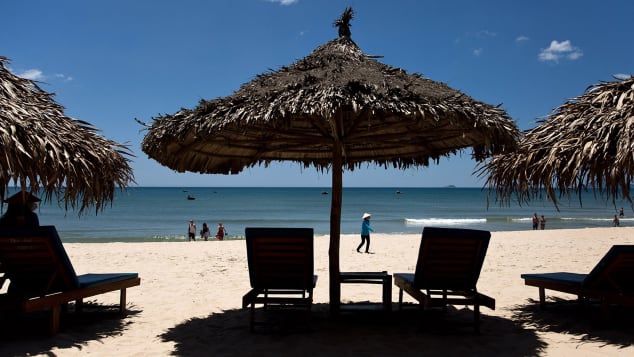
An Bàng vẫn chưa trong giai đoạn phát triển du lịch quy mô lớn, nhưng chỉ là vấn đề thời gian trước khi ai đó để mắt đến.
Cách phố cổ Hội An — di sản thế giới UNESCO — chỉ khoảng 5 km, An Bàng khiến nhiều người bất ngờ bởi sự giản dị dù nằm rất gần một điểm đến nổi tiếng.
Sau khi khám phá xong các ngôi nhà cổ và đền chùa từ thế kỷ 18 ở Hội An, hãy đạp xe xuyên qua những cánh đồng lúa xanh mướt và đàn trâu nước để đến với biển, nơi bạn có thể dành cả ngày phơi nắng thư giãn.
An Bàng thu hút đủ kiểu du khách: cả người Việt và người nước ngoài, từ già đến trẻ. Các quán ven biển đơn giản, thân thiện với gia đình phục vụ đồ uống lạnh, ghế tắm nắng, nhạc sống và tạo nên không khí vui tươi phóng khoáng. Thời gian lý tưởng nhất để đến đây là mùa khô, từ tháng 3 đến tháng 9 rồi lặn xuống dòng biển lạnh. Đó chính là liều thuốc giải nhiệt tuyệt vời cho mùa hè miền Trung.
Không giống như bờ biển phía bắc kéo dài đến Đà Nẵng, vốn rải rác các khu nghỉ dưỡng cao cấp, An Bàng hiện vẫn chưa phát triển ồ ạt — nhưng có lẽ điều đó sẽ sớm thay đổi.
Nha Trang

Có lẽ là bãi biển nổi tiếng nhất Việt Nam, Nha Trang — thuộc thành phố cùng tên — có đường bờ biển dài 6,5 km phủ cát trắng, hàng dừa và nước biển ấm, hoàn toàn miễn phí và dễ dàng tiếp cận với tất cả mọi người.
Điểm nổi bật là nơi đây có khách sạn ở mọi phân khúc, ẩm thực quốc tế và hàng loạt hoạt động giải trí: cho thuê ca nô, tour đảo giá rẻ, lặn biển, và cả công viên giải trí trên đảo được nối bằng cáp treo. Vì quá trình di chuyển dễ dàng, không có gì ngạc nhiên khi Nha Trang thu hút du khách từ khắp nơi trên thế giới, trong đó đáng chú ý là lượng du khách Nga rất lớn.
Một số người thích náo nhiệt, trong khi số khác lại tìm đến sự yên tĩnh ở phía nam thành phố, nơi các khu nghỉ dưỡng bắt đầu mọc lên dọc theo đường bờ biển dài, lộng gió đến tận sân bay quốc tế Cam Ranh. Cách Nha Trang một giờ lái xe về phía bắc, bãi cát trắng của Dốc Lết là điểm đến ưa thích cho những chuyến đi trong ngày.
Amanoi, Vĩnh Hy
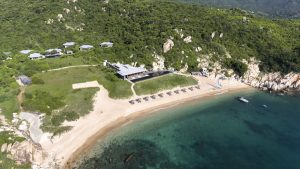
Nằm trên sườn đồi cạnh Vườn quốc gia Núi Chúa, khu nghỉ dưỡng sang trọng Amanoi sở hữu vịnh nhỏ riêng biệt với bãi cát mềm và nhà hàng ven biển.
Lái xe hai giờ về phía nam từ Nha Trang dọc theo con đường ven biển vắng vẻ để đến Amanoi, nơi nghỉ dưỡng sang trọng thuộc tập đoàn Aman danh tiếng.
Được thiết kế bởi Jean-Michel Gathy, kiến trúc tinh tế của khu nghỉ dưỡng tôn lên vẻ đẹp của Vườn quốc gia Núi Chúa — một vùng đất bán hoang mạc Việt Nam với thảm thực vật cằn cỗi và những tảng đá nằm rải rác trên các ngọn đồi. Từ đây, bạn có thể phóng tầm mắt ra vịnh Vĩnh Hy từ các vách đá dựng đứng, hoặc men theo lối đi dốc để đến với bãi biển nhỏ riêng tư và nhà hàng bên biển.
Rời Amanoi sẽ cho bạn thấy nơi này tách biệt như thế nào. Về phía bắc, những bãi biển khó tiếp cận nằm rải rác ven bờ đá. Hãy đến đảo Bình Hưng, nơi một chiếc thuyền có thể đưa bạn đến các nhà hàng nổi. Dù không phải là “fine dining” nhưng bạn sẽ thấy mình như một ông hoàng khi được phục vụ bữa tiệc tôm hùm — đặc sản địa phương — trên một chiếc bàn nhựa.
Bãi Xép, Qui Nhơn
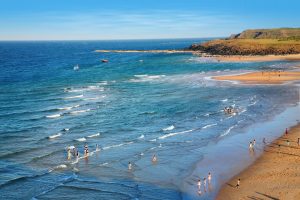
Từng là một làng chài ngủ quên bên bờ biển Việt Nam, Bãi Xép nay đã trở thành điểm đến hấp dẫn dành cho mọi mức độ ngân sách. Vịnh nhỏ nằm cách thành phố biển Quy Nhơn 10 km về phía nam này giờ có cả khách sạn năm sao và hai nhà nghỉ giá rẻ, thuộc loại sát biển rẻ nhất cả nước.
Những người phụ nữ ngồi gỡ lưới, trong khi ngư dân chèo thuyền thúng — loại thuyền truyền thống bằng tre — vào bờ. Bạn có thể nhảy lên và học cách chèo chiếc thuyền lắc lư đó chỉ với giá vài chai bia. Bãi Xép vẫn giữ được không khí địa phương và sự yên bình vốn có.
Một chuyến đi thuyền ra đảo hoang gần bờ để khám phá kiểu “Robinson”, hay đến vài vịnh gần đó để ăn trưa với hải sản tươi ngon sẽ là điểm nhấn đối lập với những giờ dài đong đưa trên võng. Nhanh chân lên — Bãi Xép chắc chắn sẽ sớm xuất hiện trên bản đồ du lịch.
Mũi Né

Chỉ cách TP. Hồ Chí Minh 210 km, Mũi Né không chỉ đơn thuần là nơi đất liền gặp biển. Những làn gió mạnh nhưng ổn định cùng giá khách sạn phải chăng đã biến nơi đây thành thủ phủ lướt ván diều của Đông Nam Á. Từ tháng 10 đến tháng 3 là thời gian lý tưởng nhất để những người đam mê môn thể thao này bay nhảy trên sóng. Người mới có thể học nhanh với các khóa dạy từ nhiều trường dạy ván diều tại đây.
Các môn thể thao dưới nước khác cũng ngày càng phổ biến như lướt sóng, lướt ván buồm, chèo ván đứng và chèo thuyền buồm. Tuy nhiên, với rất nhiều nhà hàng và quán bar bên bãi biển, chẳng ai trách bạn nếu bạn chỉ nằm thư giãn và chẳng… làm gì cả.
Việc thiếu lối vào bãi biển công cộng và phát triển tràn lan có thể không làm hài lòng tất cả mọi người. Tuy nhiên, cảng cá truyền thống và những đồi cát trắng khổng lồ gần đó là những điểm lý tưởng để ngắm hoàng hôn ngoài khu du lịch sầm uất.
Nguồn CNN Travel
